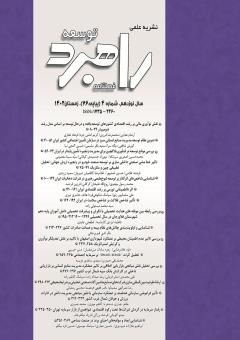بررسی تحلیل نقش میانجی بازاریابی اخلاقی بر تاثیر عملکرد مدیریت منابع انسانی بر بازاریابی داخلی در کارکنان بانک سپه شمال غرب کشور
محورهای موضوعی :
تقی محمدی
1
,
صابر قرباني
2
![]() ,
رضا عبدالله زاده
3
,
سیامک کاظم زاده
4
,
رضا عبدالله زاده
3
,
سیامک کاظم زاده
4
![]()
1 - 0استادیار، مدیریت منابع انسانی،گروه مدیریت، واحدخوی، مرکز قره ضیاالدین، دانشگاه آزاداسلامی، خوی، ایران (نویسندهمسئول
2 - عضو هیات علمی دانشگاه آزاد
3 - استادیار ،مدیریت صنعتی ، گروه مدیریت ، واحد خوی، مرکز قره ضیالدین، دانشگاه آزاد اسلامی، خوی، ایران
4 - عضو هئیت علمی، گروه مدیریت، دانشگاه آزاد اسلامی واحد ماکو،ماکو، ایران
کلید واژه: کلید واژه: بازاریابی اخلاقی, مدیریت منابع انسانی, بازاریابی داخلی, کارکنان بانک سپه شمال غرب کشور طبقه بندیJEL: M12,
چکیده مقاله :
چكيده هدف:.هدف از این تحقیق تحلیل نقش میانجی بازاریابی اخلاقی بر تاثیر عملکرد مدیریت منابع انسانی بر بازاریابی داخلی در کارکنان بانک سپه شمال غرب کشور می باشد. روش شناسی: این پژوهش از لحاظ هدف کاربردی و از نظر روش، توصیفی پیمایشی بود. جامعه آماری پژوهش کلیه کارکنان شعب بانک سپه شهر سلماس و خوی به تعداد 160 بود. حجم نمونه با استفاده از جدول مورگان، 113 نفر و روش نمونه گیری تصادفی ساده می باشد. ابزار پژوهش پرسشنامه های استاندارد بازاریابی داخلی (مونی و فورمن ؛1995)، پرسشنامه بازاریابی اخلاقی صفری و همکاران (1396) و پرسشنامه استاندارد عملکرد مدیریت منابع انسانی آندری. ای. دیوال (2004) بود. به منظور آزمون فرضیه های پژوهش از روش معادلات ساختاری و نرم افزارهایPLS و SPSS19 استفاده شد. یافته ها: :تجزیه و تحلیل داده ها نشان داد که عملکرد مدیریت منابع انسانی بر بازاریابی داخلی با نقش میانجی بازاریابی اخلاقی تاثیر دارد. عملکرد مدیریت منابع انسانی بر بازاریابی اخلاقی تاثیر مثبت و معنادار دارد. بازاریابی اخلاقی بر بازاریابی داخلی تاثیر مثبت و معنادار دارد. عملکرد مدیریت منابع انسانی بر بازاریابی داخلی تاثیر مثبت و معنادار دارد. نتیجه گیری: بهبود کیفیت عملکرد منابع انسانی سازمان می تواند منجر به کسب مزیت رقابتی و بهبود عملکرد سازمان گردد . بهبود کیفیت عملکرد منابع انسانی و کارکنان بانک وابسته به جلب رضایت آنها به عنوان مشتریان درونی سازمان است و مدیریت بانک به واسطه بازاریابی داخلی می تواند مهارت ها، نگرش ها و رفتار کارکنان را در جهت اهداف بانک هدایت نماید
Taghi Mohammadi Saber Ghorbani Reza Abdulzadeh Siamak Kazemzadeh Abstract Purpose:. The purpose of this research is to analyze the mediating role of ethical marketing on the effect of human resource management on internal marketing among the employees of Sepeh Bank in the northwest of the country. Methodology: This research was applied in terms of purpose and descriptive survey in terms of method. The statistical population of the research was 160 employees of Sepeh Bank branches in Selmas and Khoi. The sample size is 113 people using Morgan table and simple random sampling method. The research tools are internal marketing standard questionnaires (Mooney and Forman; 1995), Safari et al.'s ethical marketing questionnaire (2016) and Andrey's standard human resource management performance questionnaire. Oh you. It was Deval (2004). Structural equation method and PLS and SPSS19 software were used to test the research hypotheses Findings: Data analysis showed that the performance of human resources management has an effect on internal marketing with the mediating role of ethical marketing. The performance of human resources management has a positive and meaningful effect on ethical marketing. Ethical marketing has a positive and significant effect on internal marketing. The performance of human resources management has a positive and significant effect on internal marketing. Conclusion: Improving the quality of the organization's human resources performance can lead to gaining a competitive advantage and improving the organization's performance. Improving the performance quality of human resources and bank employees is dependent on their satisfaction as internal customers of the organization, and bank management can direct the skills, attitudes and behavior of employees towards the bank's goals through internal marketing.


